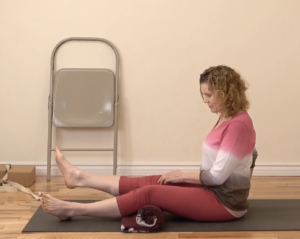
by Barrie
One of the most effective ways to stabilize and protect your knees with yoga is to strengthen your front thigh muscles, the quadricep muscles (aka quads). A study conducted by the Mayo Clinic Greater Quadriceps Strength May Benefit Those with Knee Osteoarthritis on the link between quadriceps strength and the risk of cartilage loss and knee osteoarthritis, concluded that:
“Our findings, which also include an association of greater quadriceps strength with less knee pain and physical limitation over follow up, suggest that greater quadriceps strength has an overall beneficial effect on symptomatic knee osteoarthritis.”
In particular, it’s important to strengthen your innermost quadricep muscles, the vastus medialis muscles. These are the muscles that runs from your upper inner thighs down to the top of your kneecaps. When you straighten your leg, they contract, which strengthens them. So practicing yoga’s standing poses with straight legs, such as Triangle pose and Pyramid pose, can be particularly helpful, as can straightening your legs fully when moving in and out of bent leg poses in a vinyasa practice.
Since the vastus medialis muscle is activated only with the last bit of leg straightening, in all poses with straight legs, focus on tightening your kneecaps as if you were drawing them up toward the tops of your legs, as you fully straighten your legs in these poses.
Weakness in the vastus medialis muscles, which is common when we don’t actively work on strengthening it through straightening our legs fully, is considered to be a significant cause of knee pain. This weakness affects the way the knee moves, how the kneecaps track when they bend, and how they absorb the forces of movement. All of this can create knee instability and especially place excess strain on the inner knees, which can lead to cartilage loss and eventually to osteoarthritis.
Therefore, strengthening the vastus medialis muscles can help to improve knee stability and function, reduce pain, as well as the risk of cartilage injuries. I’ve experienced this myself.
Several years ago, I had pain in one of my inner knees that was diagnosed as a tear in my meniscus—the cartilage that acts as a shock absorber between your shinbone and thighbone. That’s when a fellow yoga teacher taught me this simple exercise to locate and activate the vastus medialis muscles. I practiced it regularly and it really helped to bring greater awareness to these muscles (and how weak they were at the time) and to target them so I could work on strengthening them. Over time, not only did my meniscus tear heal—or at least stopped causing me pain—but I also became much more aware of using these muscles in my yoga practice to help prevent future pain from occurring.
Because this issue is so common, it’s an exercise I’ve taught to many students over the years, with excellent results. Here’s a short video in which I demonstrate the exercise. If you try it, I’d love to know how it goes for you!
Download a free class from Barrie’s new Yoga for Times of Change companion video series and learn more about her book Evolving Your Yoga: Ten Principles for Enlightened Practice at www.barrierisman.com.
• Follow Yoga for Healthy Aging on Facebook and follow Nina on Instagram • Order Yoga for Times of Change here and purchase the companion videos here • Order Yoga for Healthy Aging: A Guide to Lifelong Well-Being here.


Leave A Comment